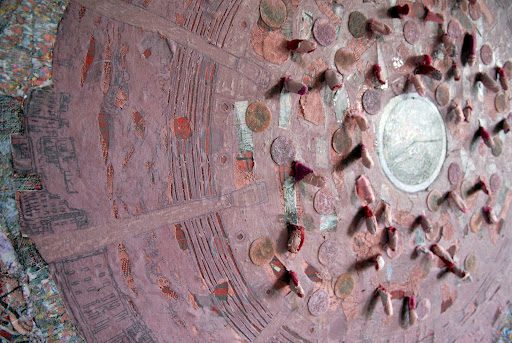Review by Colin Herd
In July 2010, the painter Heather Ross (b.1983) won the Alastair Salvesen Travel Scholarship, a funding opportunity aimed at young artists who have recently made the transition from studying in college to working as an artist. The award enabled Ross to embark on a three-month study/research trip, visiting many contrasting locations in Japan, including Tokyo, Hakone, Kamakura, Beppu, Hiroshima and Kyoto. The work she produced resulting from the trip currently forms a small but densely-packed exhibition at the Royal Scottish Academy.
As the title of the show suggests, Ross’s work complicates and blurs the idea that there are specific periods of research and study as opposed to periods of practice. Research is a part of practice and practice a form of research, each activity inseparable from the other. In the introductory text to the exhibition, she writes: “I’m in a constant state of practice, each piece of work contributing to the next, sated momentarily, until a new curiosity emerges.” It’s fitting and very effective, then, that the paintings that make up this exhibition are displayed alongside a wealth of research material: dog-eared travel guides, pages torn from advertisements and articles in magazines (including surreal and eerie images of Japanese girls on chopping boards and a blender filled with what look like maggots but which up close are female figures, slowly churning reddish from the base up), sketch books, her Japan Rail ticket, a copy of The Tale of Genji, postcards, fabric and textiles, and texts exerted from books about Japanese bathing rituals. These materials, which sit in vitrines alongside more ‘finished’ works, are fascinating collages or assemblages in their own right, providing an insight into Ross’s responsiveness and playfulness as an artist, her interests in the implications of technology and feminism. Above all else, they’re a testament to her extraordinarily deft and thoughtful visual alertness.
A central metaphor runs through the paintings in Constants in Practice of painting as akin to Japanese bathhouse bathing rituals. Ross is fascinated and compelled by the lengthy ritualistic process of washing and scrubbing, paying heed to the body in sections, prior to soaking. In her paintings, this process is reflected in the heavy use of skin-tones, a technique in some works of top-layering with thick soap-like resin and most of all a kind of physical attention to the layers and surfaces of paint. There’s a strong effect in some areas of the canvases of being scrubbed back, reworked and rubbed off towards a level of purity. In Exorcising the Impure, Hakone, 18th July 2010, a gushing torrent of blue and white to look like water splits the canvas down the middle, in the manner of the waterfalls in Classical Japanese paintings. Either side of the torrent are dark, muddy coloured wing-like sections in which small masks or faces (presumably the impure elements- they look like muscles or oysters) drift off as though in the steam from the torrent, mingling with red strips (the bureaucratic red-tape of working lives?).
Similarly, in Bathing Practice, a thick layer of resin makes fossilizes the image, gives it the impression of being out-of-reach and precious. The painting is dominated by amber shapes, like limbs or human forms bent over double. Beside them, there are darker versions, like shadows, or spirits. The painting is distinguished by its impressive use of layering, at the base, and only discernible when peering close, is the trace of a leaf-pattern as you’d find on tile floors. You get a strong sense of preservation, almost of archaeology; the painting speaks the decline of bathhouse culture but its importance too. (The number of Japanese bathhouses has dramatically declined but they still have an important place in society with over 12,000 still in existence.)
The watercolour Takegawara Refuge, Beppu features a central grid made up of straight lines like an architectural plan. These are softened and opposed with generous splashes of watery pink, thin and soggy so the paper waves a little in its frame. The painting presents two complementary forms of purity: geometric and aquatic. Plans and maps are a recurring feature of the show, from “Time Out Tokyo” in the vitrines to beautiful sketchy hand-drawn maps. The most striking use of a plan is The Story of the Little Boy, 6th August, 8.15 am, a large painting, the centre of which is based on the plan of the circular Hall of Remembrance at Hiroshima. The edges of the painting are filled with criss-crossing shards. Moving inwards there’s a kind of thin atmosphere around the central portion of the painting, flecks of coloured paint and shiny sparkles, like dust particles being drawn inwards. Next there are what look like little floppy altars, fabric finger puppets, some as if they’re bending down and some as if they’re rising. They intermingle with flat spongy discs (the sort you’d use to remove make up), caked in powdery paint. The base of the painting is pink, but a rich pink made up of many different pinks, silvers and white. The specific time given in the title makes it look a little like a clock. It’s an extremely impressive painting, difficult to talk about without simply describing its elements, its layers.
The image conveys a strong sense of patience and reverence, a dreamlike strangeness, a sense of being in the space, speechlessness and awe. It shares with the other paintings in Constants in Practice a seamless and delicate blend of the contemplative and the physical, the body and the ritual, through which the exhibition fascinatingly opens for exploration many of the contrasts and balances in Japanese culture between tradition and modernization, gender roles, city and countryside.
Heather Ross: Constants in Practice is on display at the Royal Scottish Academy, Edinburgh until 26 July.
royalscottishacademy.org
Aesthetica Magazine
We hope you enjoying reading the Aesthetica Blog, if you want to explore more of the best in contemporary arts and culture you should read us in print too. In the spirit of celebration, Issue 41 includes a piece on Guggenheimn Bilbao where the Luminous Interval features internationally acclaimed artists such as Louise Bourgeois, Kiki Smith and Damien Hirst, ArtAngel’s new commission at MIF, Bruce Nauman’s retrospective at The Kunsthalle Mannheim and Cory Arcangel’s Pro Tools at the Whitney in NYC. You can buy it today by calling +44(0)1904 479 168. Even better, subscribe to Aesthetica and save 20%. Go on, enjoy!
Image: Courtesy the artist Photography: Chris Park





